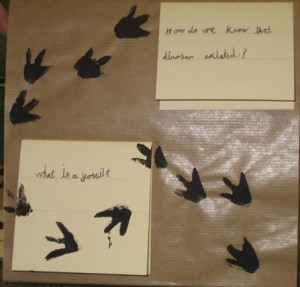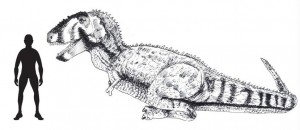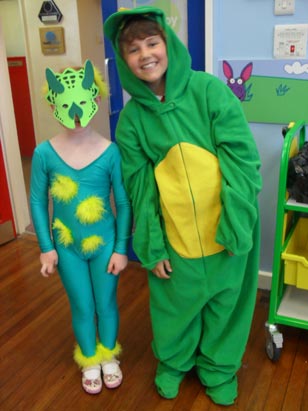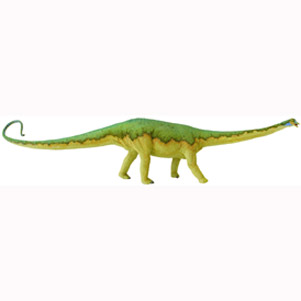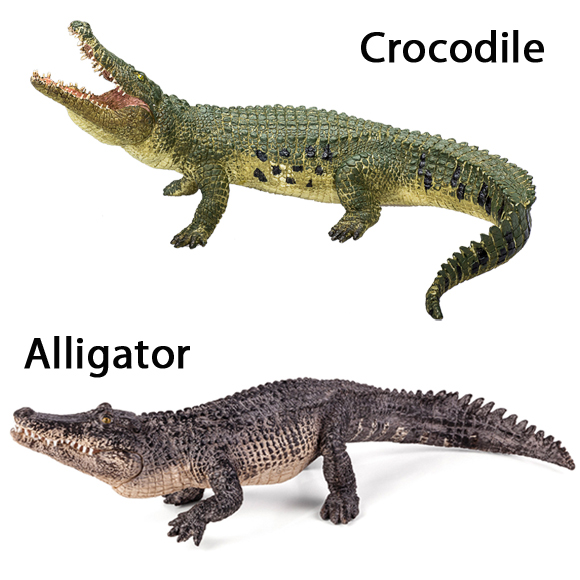South African Scientists Intend not to Leave Australopithecus sediba “On the Shelf”
An innocuous looking slab of rock, simply known as Block 051 lay in a storage area of a South African laboratory for three years as scientists went about their daily business. By chance a technician took a closer look at the one-metre wide rock and spotted a small, whitish object sticking out from it – on closer examination it turned out to be a fossilised tooth of a two-million-year-old hominid. This was only the start, as palaeoanthropologists believe that this greyish rock nodule may contain the most complete fossilised skeleton yet discovered of Australopithecus sediba. An amazing early human fossil found in a laboratory.
Rock May Reveal Evidence of Human Evolution

Scientist points to the tooth and shows replica skull of hominid.
Picture credit: AFP
Early Human Fossil
Scientists from the Wits Institute for Human Evolution based at the University of the Witwatersrand in Johannesburg (South Africa) have announced the discovery of a significant amount of a skeleton of a potential early human ancestor. The skeleton is believed to be the remains of ‘Karabo’, the type skeleton of Australopithecus sediba, discovered at the Malapa Site in the Cradle of Humankind in 2009.
The remains, embedded in the rock may consist of elements of the skull plus ribs and parts of the limbs from a hominid that lived two million years ago. Scientists are unsure as to whether the fossils represent a male or a female but a preliminary examination suggests that the bones may belong to a juvenile, aged between nine and thirteen years when they died.
Professor Lee Berger, a Reader in Palaeoanthropology and the Public Understanding of Science at the Wits Institute for Human Evolution made the announcement. Professor Berger and his team at the University of Witwatersrand have been at the centre of the research into A. sediba fossil specimens and have excavated a number of highly significant finds of South African hominid fossils in recent years.
To read an early article on the University’s research: Fossil Find may Help to Determine how Humans Evolved.
Professor Berger commented:
“We have discovered parts of a jaw and critical aspects of the body including what appear to be a complete femur (thigh bone), ribs, vertebrae and other important limb elements, some never before seen in such completeness in the human fossil record.”
The Professor went on to add:
“This discovery will almost certainly make Karabo the most complete early human ancestor skeleton ever discovered. We are obviously quite excited as it appears that we now have some of the most critical and complete remains of the skeleton, albeit encased in solid rock. It’s a big day for us as a team and for our field as a whole.”
The fossils are not visible on the surface of the rock, but encased within it. Although the rock had been brought back to the laboratory three years ago it lay unnoticed in the Wits laboratories until early June. With the tooth spotted, Professor Berger and his wife Jackie Smilg, a radiologist at the Charlotte Maxeke Hospital, who is conducting her PhD on the CT scanning of fossil material embedded in rock, scanned the large rock in a state of the art CT scanner.
A Preliminary Scan Reveals Substantial Fossil Material in the Matrix

Initial scan of the matrix proves promising.
Picture credit: University of Witswatersrand (Johannesburg)
The picture shows a probable hominin fibula (circled), in the rock known as block 051. Note the shaft of a probable femur just above and to the left.
The scans reveal tantalising glimpses of the fossil material that lies within the rock. In an unprecedented gesture of open access to science and public participation, the University of the Witwatersrand, the Gauteng Provincial Government and the South African national government have announced that for the first time in history, the process of exploring and uncovering these fossil remains would be conducted live, captured on video, and conveyed to the world in real time. This will allow members of the public and the scientific community to share in the unfolding discovery in an unprecedented way.
A spokesperson for Everything Dinosaur commentated:
“This is a very exciting development, giving members of the public open access to palaeoanthropology as it happens, people will get to see the fossils at the same time as the scientists”.
For replicas and models of early hominins and prehistoric animals: (Safari Ltd) – Replicas of Early Humans and Prehistoric Animals.
A laboratory studio, designed in collaboration with the National Geographic Society, will be built at the Maropeng Visitor Centre in the heart of the Cradle of Humankind World Heritage Site. It will allow the public to view the preparation of this skeleton live if they visit Maropeng, or live on the internet.
Access to the laboratory studio will not be limited only to visitors to the Cradle of Humankind and the internet as Professor Berger explained:
“We intend to create virtual ‘outposts’ in major partner museums around the world. These outposts will allow visitors to these partner museums the chance to interact with scientists in real time in a way we simply could not conceive of a few years ago. It is anticipated that the laboratory and virtual infrastructure will be built within a year, expanding our ambitious tourism and smart province infrastructure programme.”
Berger added that negotiations have begun with the Shanghai Science and Technology Museum, the Natural History Museum in the United Kingdom and the Smithsonian in Washington.
Pointing out the Evidence – The Tooth

Pointing out the tooth… “the whole tooth and nothing but the tooth”.
Picture credit: University of Witswatersrand (Johannesburg) with additional annotation by Everything Dinosaur.
The photograph above shows the tooth of a hominid embedded in a rock containing significant parts of a skeleton of an early human ancestor. The skeleton is believed to be the remains of “Karabo”, the type skeleton of Australopithecus sediba, discovered at the Malapa Site in the Cradle of Humankind in 2009. Team members at Everything Dinosaur have highlighted the tooth with a red circle.
Looks like it is going to be an exciting time for some of the candidate hominids involved in the search for the direct ancestry of our own species.
Everything Dinosaur is grateful to the University of Witwatersrand for the compilation of this article.



